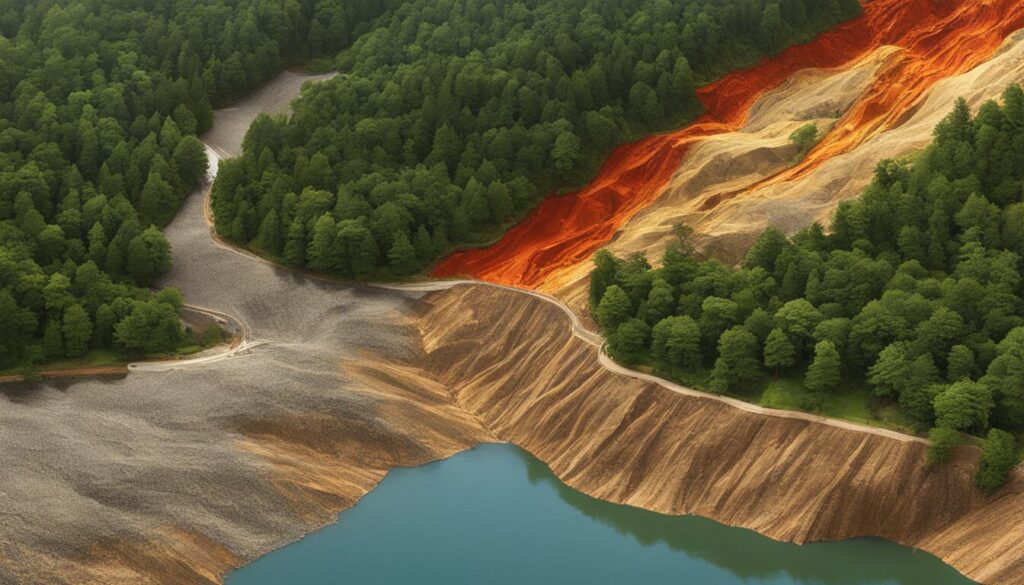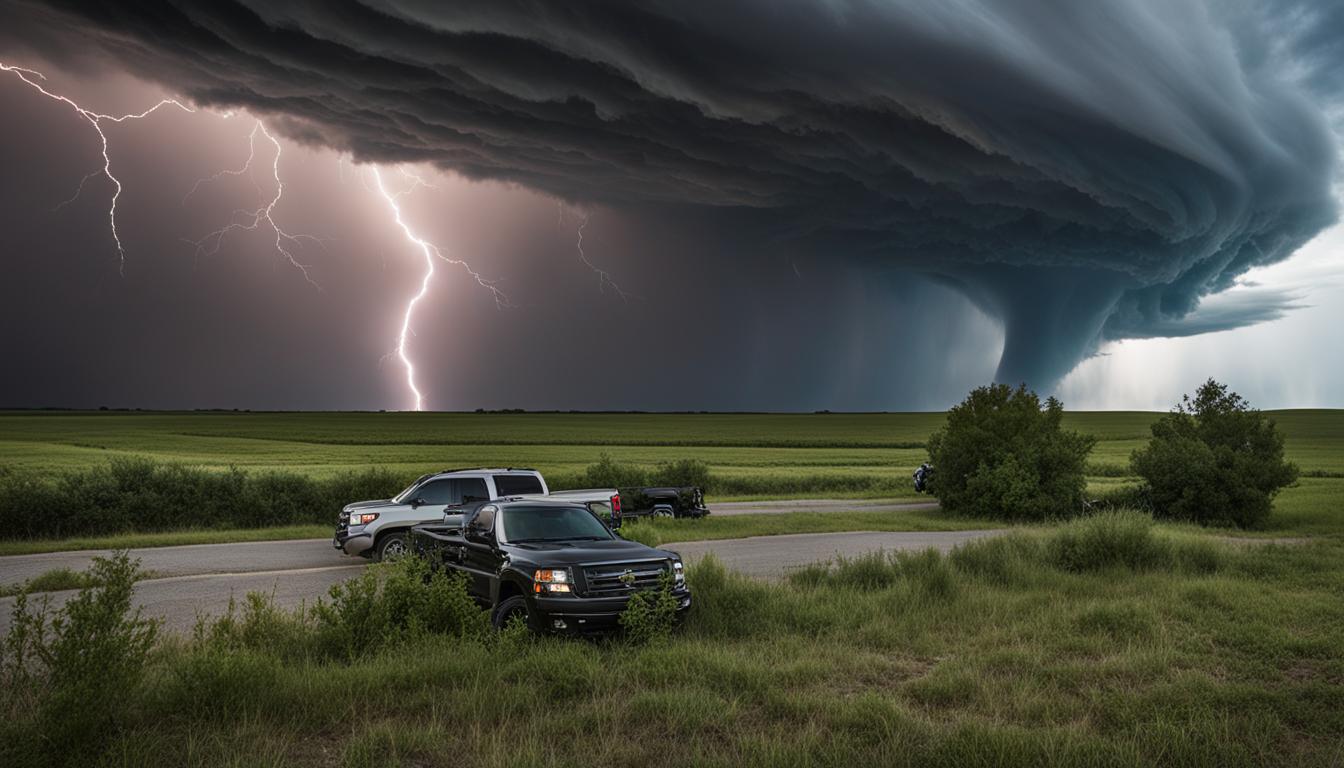Liquefaction and landslides are two distinct geological hazards that can have devastating effects. Liquefaction occurs in areas with soft, saturated soils, where the shaking of an earthquake causes the soil to behave like a liquid instead of a solid. This can lead to buildings tilting and sinking, utilities coming to the surface, and roadways cracking. On the other hand, landslides occur in sloped areas due to factors such as erosion, rainfall, or earthquake shaking. They can range from slow-moving earthflows to fast-moving rock avalanches, all of which can cause significant damage. The causes of liquefaction and landslides differ, with liquefaction being primarily triggered by earthquake shaking and landslides being triggered by various factors including rainfall and building structures on unstable slopes.
Key Takeaways:
- Liquefaction occurs in soft, saturated soils during earthquakes, while landslides occur in sloped areas due to various factors.
- Liquefaction can lead to buildings tilting and sinking, while landslides can cause significant damage, ranging from slow-moving earthflows to fast-moving rock avalanches.
- The causes of liquefaction primarily include earthquake shaking, while landslides can be triggered by factors such as rainfall and unstable slopes.
- Understanding the differences between liquefaction and landslides is crucial for assessing and mitigating the risks associated with these hazards.
- Geotechnical analysis plays a vital role in evaluating and mitigating the risks of liquefaction and landslides.
Please note that the image link provided in the example is just a placeholder and may not be an actual image related to the topic.
Causes and Effects of Liquefaction
Liquefaction is a geological process that occurs during an earthquake, where soft, saturated soil loses its strength and behaves like a liquid. This phenomenon can have significant effects on the surrounding environment, infrastructure, and communities. The process of liquefaction primarily occurs in areas with soft, water-saturated soils, such as coastal regions or areas near bodies of water. These types of soils are particularly susceptible to liquefaction due to their loose nature and the presence of excess water.
Geotechnical analysis of liquefaction is crucial in assessing the risks associated with this process. It involves evaluating the susceptibility of an area to liquefaction and providing recommendations to mitigate these risks. Geotechnical engineers conduct various tests, such as determining the soil’s liquefaction potential and assessing the liquefaction-induced ground displacement. By understanding the geotechnical characteristics of the soil and evaluating the seismic hazard, engineers can develop strategies to minimize the impact of liquefaction on infrastructure and prevent potential disasters.
“The risk of liquefaction should not be underestimated,” says Dr. Lisa Thompson, a geotechnical expert at the University of XYZ. “It can lead to severe damage to buildings, utilities, and lifeline systems, posing a grave threat to public safety.”
The effects of liquefaction can be devastating. Buildings may tilt, sink, or collapse, disrupting the lives of the people who live and work in them. Utilities such as water and sewer lines can be displaced, resulting in disruptions to essential services. Roadways and transportation infrastructure may crack or become impassable, further complicating rescue and recovery efforts. Therefore, it is vital to consider the risks of liquefaction and implement appropriate mitigation measures to protect lives, property, and critical infrastructure.
| Causes of Liquefaction | Effects of Liquefaction |
|---|---|
|
|
Summary
Liquefaction is a geotechnical phenomenon that occurs during earthquakes in areas with soft, water-saturated soils. It can lead to severe damage to buildings, utilities, and roadways. Geotechnical analysis is crucial in assessing the risks associated with liquefaction and developing strategies to mitigate its effects. By understanding the causes and effects of liquefaction, communities can take proactive measures to protect lives and infrastructure from this hazardous process.
Causes and Types of Landslides
Landslides are geological hazards that can cause significant damage to communities and infrastructure. They can be triggered by various factors, including erosion, rainfall, snow, and earthquake shaking. The specific type of landslide that occurs depends on the characteristics and conditions of the slope. Understanding the causes and types of landslides is crucial for assessing the risks associated with these hazards.
Causes of Landslides
Landslides can occur due to natural or human-induced factors. Natural causes include heavy rainfall, which saturates the soil and increases the likelihood of slope failure. Erosion, especially in areas with steep slopes, can weaken the stability of the slope over time. Earthquakes can also trigger landslides, as the shaking of the ground can disturb the balance of the soil and cause it to slide downhill.
Human activities can contribute to landslides as well. Clear-cutting of trees and vegetation can lead to the loss of root systems that help stabilize the soil. Excavation and construction on steep slopes without proper engineering measures can also increase the risk of landslides.
Types of Landslides
Landslides can manifest in different forms, depending on the movement of the mass of soil or rock. The common types of landslides include:
- Rockfalls: Occur when rocks detach from a steep slope and fall, often due to weathering or seismic activity.
- Rock slides: Involve the rapid movement of a mass of rock along a distinct sliding surface. They can occur on steep slopes or in areas with weak rock formations.
- Slumps: Characterized by the downward movement of a mass of soil or rock along a curved surface. Slumps often occur in areas with weak or saturated soils.
- Block slides: Involve the movement of large blocks of rock or soil along a nearly vertical plane. They can be triggered by seismic activity or the saturation of the soil.
- Rapid soil flows: Refer to the rapid movement of water-saturated soil or debris downslope, often with high velocities.
Each type of landslide has its own unique characteristics and poses different risks to communities and infrastructure. Understanding these types is essential for implementing effective prevention measures and mitigating the hazards associated with landslides.
| Type of Landslide | Main Causes |
|---|---|
| Rockfalls | Weathering, seismic activity |
| Rock slides | Steep slopes, weak rock formations |
| Slumps | Weak or saturated soils |
| Block slides | Seismic activity, saturated soil |
| Rapid soil flows | Water-saturated soil, debris |
The table above provides a summary of the main types of landslides and their causes. By understanding the causes and types of landslides, communities and infrastructure can be better prepared to mitigate the risks and minimize the potential impact of these hazardous events.

Difference Between Earthquake-Induced Liquefaction and Landslides
While both liquefaction and landslides can be triggered by earthquakes, they have distinct characteristics. Liquefaction is primarily caused by the shaking of the ground during an earthquake, resulting in the loss of soil strength and the transformation of solid soil into a liquid-like state. On the other hand, landslides can be triggered by various factors, including earthquake shaking, but they can also occur due to factors such as erosion, rainfall, and the construction of structures on unstable slopes.
The mechanisms and behaviors of liquefaction and landslides differ, highlighting the importance of understanding these hazards separately. Liquefaction occurs in areas with soft, saturated soils, typically in coastal areas or areas near bodies of water. The shaking of an earthquake causes the soil particles to lose their interlock and fill void spaces with water, resulting in a sudden change from a solid to a liquid-like state. This can lead to buildings tilting and sinking, utilities being disrupted, and roadways cracking or becoming impassable.
In contrast, landslides occur in sloped areas and can be triggered by various factors. These include erosion, rainfall, snow, and earthquake shaking. The specific type of landslide that occurs depends on the conditions and characteristics of the slope. Common types of landslides include shallow rock falls, rock slides, slumps, block slides, and rapid soil flows. Landslide hazards are most prevalent in mountainous or sloping terrain and can have devastating effects on communities and infrastructure.
Evaluating and Mitigating Liquefaction and Landslide Risks
To ensure the safety of communities and infrastructure, it is crucial to evaluate and mitigate the risks associated with liquefaction and landslides. Geotechnical analysis plays a key role in assessing the susceptibility of an area to these hazards and providing recommendations for risk reduction.
For liquefaction, ground improvement techniques are commonly employed to increase the stability of the soil. These techniques may include the use of deep foundations, such as piles or stone columns, to reinforce the ground and prevent liquefaction. Additionally, soil stabilization methods, such as compaction or the injection of cementitious materials, can be utilized to improve the strength and resilience of the soil.
Furthermore, fortifying structures against liquefaction is essential for minimizing the potential damage. This can involve designing buildings with flexible foundations that can accommodate the liquefaction-induced ground deformation. In some cases, rigid foundations may be used in combination with ground improvement techniques to enhance overall stability. By implementing these measures, the risks associated with liquefaction can be effectively mitigated.
| Geotechnical Analysis Techniques for Liquefaction Risk Evaluation | Liquefaction Risk Mitigation Measures |
|---|---|
| Soil borings and sampling | Ground improvement techniques such as deep foundations and soil stabilization |
| In situ testing and laboratory analysis | Fortifying structures to withstand ground deformation |
| Geophysical methods (e.g., seismic refraction, resistivity, and shear wave velocity tests) | Designing buildings with flexible foundations |
In the case of landslides, prevention measures focus on minimizing slope instability and reducing erosion. Afforestation and reforestation efforts can be undertaken to stabilize slopes and promote the growth of vegetation, which helps bind the soil and control erosion. Additionally, the construction of retaining walls, terracing, or stabilizing slopes with geosynthetics can enhance slope stability and prevent landslide occurrences.
It is also crucial to avoid construction activities near unstable slopes and to implement proper drainage systems to manage rainfall runoff effectively. Regular monitoring of slopes and early warning systems can provide vital information and allow for timely evacuation in the event of landslide hazards.
“Proactive measures such as afforestation and slope stabilization through the use of retaining walls and geosynthetics are essential in mitigating landslide risks.”
Key Measures for Landslide Risk Reduction
- Afforestation and reforestation to stabilize slopes and control erosion
- Construction of retaining walls and terracing to enhance slope stability
- Stabilizing slopes with geosynthetics
- Avoiding construction activities near unstable slopes
- Implementing proper drainage systems to manage rainfall runoff
- Regular monitoring of slopes and implementation of early warning systems
By employing geotechnical analysis and implementing risk mitigation measures, communities and infrastructure can be better prepared and protected from the potential devastation caused by liquefaction and landslides.
Conclusion
In conclusion, it is essential to understand the difference between liquefaction and landslides to effectively assess and mitigate the risks associated with these geological hazards. Liquefaction occurs in areas with soft, saturated soils during earthquake shaking, leading to a loss of soil strength and a liquid-like behavior. On the other hand, landslides can be triggered by various factors such as rainfall, erosion, and slope instability, in addition to earthquake shaking.
Both liquefaction and landslides pose significant risks to communities and infrastructure. Liquefaction can result in tilting and sinking buildings, disrupted utilities, and damaged roadways. Landslides, depending on their type, can range from slow-moving earthflows to fast-moving rock avalanches, causing severe damage.
To mitigate the risks, geotechnical analysis plays a crucial role. By assessing the susceptibility of an area to liquefaction or landslides, experts can provide recommendations for effective risk reduction measures. For liquefaction, ground improvement techniques and fortifying structures to withstand liquefaction are crucial. For landslides, minimizing clear-cutting trees, adding more vegetation, and avoiding construction near unstable slopes are recommended prevention measures.
By considering these factors and implementing appropriate measures, communities and infrastructure can be better prepared and protected from the potential devastation of liquefaction and landslides. It is vital to prioritize the understanding and management of these hazards to ensure the safety and resilience of our landscapes.
FAQ
What is liquefaction?
Liquefaction occurs when soft, saturated soil loses its strength during an earthquake, causing it to behave like a liquid instead of a solid.
What are the effects of liquefaction?
Liquefaction can lead to buildings tilting and sinking, utilities being disrupted, and roadways cracking or becoming impassable.
Why is liquefaction more common in coastal areas?
The risk of liquefaction is higher in coastal areas or areas near bodies of water due to the soft, saturated soil present in these locations.
What causes landslides?
Landslides can be caused by factors such as erosion, rainfall, snow, and earthquake shaking.
What are the types of landslides?
Common types of landslides include shallow rock falls, rock slides, slumps, block slides, and rapid soil flows.
Where are landslide hazards most prevalent?
Landslide hazards are most prevalent in mountainous or sloping terrain.
How can landslide risks be mitigated?
Measures such as minimizing clear-cutting trees, adding more vegetation, monitoring erosion, and avoiding construction near unstable slopes can help reduce landslide risks.
What is the difference between liquefaction and landslides?
Liquefaction is primarily caused by earthquake shaking, while landslides can be triggered by various factors including earthquakes, rainfall, and slope instability.
What is geotechnical analysis?
Geotechnical analysis involves assessing the susceptibility of an area to liquefaction or landslides and providing recommendations for mitigating the risks.
How can liquefaction and landslides be evaluated and mitigated?
Geotechnical analysis is often conducted to evaluate the risks and provide recommendations, which may include ground improvement techniques and fortifying structures for liquefaction, and implementing measures to reduce landslide risks.



